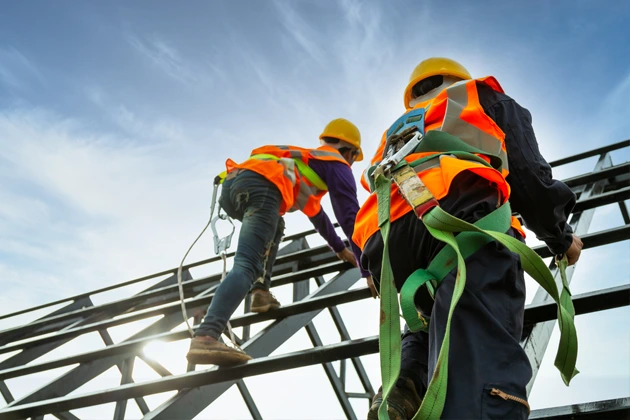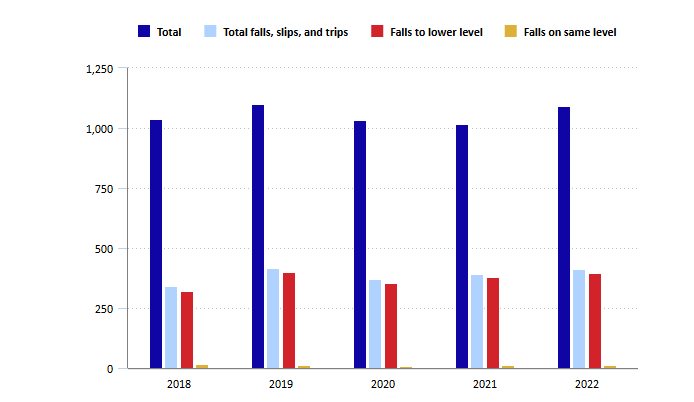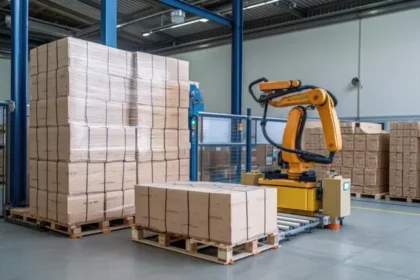When is fall protection required in the construction industry? This is a buzzing question that many working in the sector of the United States ask frequently. Although the answer seems to be easy, fall protection, in actuality, has many requirements within the construction industry. Let us know what fall protection is in construction and what its requirements are.
Fall Protection in Construction
In the construction sector, falls are the leading cause of casualty. As per the Bureau of Labor Statistics, nearly 412 people died of falls, slips, and trips in the construction sector in 2022. The construction industry accounted for 47.4% of all fatal falls, slips, and trips in the same year. These statistics unveil the cases of fatalities, including falls in the industry, justifying the need for fall protection.
(Bureau of Labor Statistics, 2022)
According to OSHA, fall incidents involve various factors. Consequently, fall protection standards cover both human and equipment-driven fall issues to protect workers. Under the Fall Protection legislation, Subpart M demonstrates the requirements for fall protection in construction sites. It encompasses workers working at six feet or more heights, along with some other requirements. However, it doesn’t apply to workers inspecting and assessing workplace conditions before the actual work starts.
Fall Protection Requirements
Subpart-M states the below-given fall protection requirements in the construction sector-
- Applies to workers working at heights of six feet or more above a lower level.
- Fall protection is offered to protect workers from falling objects, falling through holes, and falling from tripping over.
- It also protects from falls while walking and working around dangerous equipment, even when they are not kept at heights.
When is Fall Protection Required in the Construction Sector: A Few Examples
-
Leading Edges
Workers involved in the construction of a leading edge that is six feet or more above the lower level are given fall protection through guardrail systems, personal fall arrest systems, or safety net systems. Workers are also protected with these systems while they are on a working surface of six feet or more.
-
Roofing Work on Low-Slope Roofs and Steep Roofs
While engaged in roofing work for a low-slope roof, with one or more unprotected sides six feet above lower levels, workers are given protection from falling. Alongside guardrails, safety nets, and personal fall arrest systems, protection is offered through warning line systems and a combined fall protection system. Workers are also protected using a safety monitoring system. The fall protection requirement is the same for workers working on steep roofs with one or more unprotected sides.
-
Overhand Bricklaying and Associated Works
Workers doing overhand bricklaying and related work must be given protection through safety nets, guardrails, or personal fall systems. Such workers are often advised to work in a controlled access zone to prevent falls.
-
Residential Construction
In terms of residential construction, workers must be given conventional fall protection unless an alternative fall protection system is allowed by another provision. However, the construction work under OSHA covers any construction that is built as a dwelling and any structure built with wood frame construction materials and processes.
In order to answer the question, ‘When is fall protection required in the construction industry? ‘, it can be said that fall protection is applicable in varied scenarios, but a minimum height of six feet is required to use the system. Employers in the construction industry must have access to conventional fall protection systems, i.e., guardrails, safety nets, and personal fall arrest systems. They must also have a site-specific fall protection plan that meets the requirements. With the Fall protection system in action, the occupational safety of construction workers is made secure.











